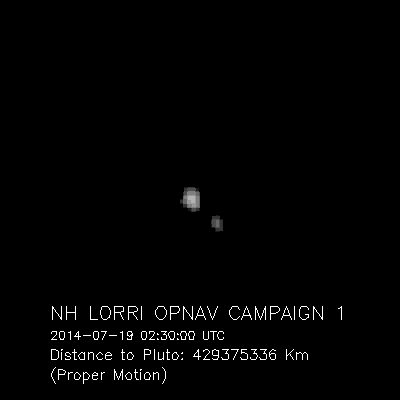The New Horizon's probe has been sailing through the murky black of space for almost a decade, with little to report but some atmospheric and magnetosphere tests when receiving a gravity assist from Jupiter. That was all part of the plan though, to bring the space-craft into a nearby encounter with the dwarf planet Pluto. With that on-track to take place in July this year, New Horizon has been awoken and is now taking long-range images of the stellar body and its moons.
At this stage, it's still some 200 million miles away, so the images being taken don't show us anything that will break new bounds in science, but they will help NASA make adjustments to its course, to help refine its encounter and bring it in ever closer to what was once called the ninth planet in our solar system. Sadly, however many corrections NASA makes, it won't be possible to enter into orit around Pluto. Being only 2,400 KM in diameter, its gravitational pull isn't enough to capture New Horizon, which in order to reach the Kuiper Belt for an encounter with Pluto, is travelling at some 14 kilometres per second (31,317MPH).
That means that the flyby with the dwarf planet will be very quick, giving NASA little time for error in making its measurements and taking pictures; especially considering many of the instruments require usage at specific distances from Pluto. At the closest, we can expect New Horizons to fly past at a distance just shy of 14,000 KM, on the 14th July. Up until that point, images will be taken, gradually increasing in clarity as the ship gets ever closer.
While this might seem like a great distance, it will allow for an unparalleled look at the dwarf-planet, sending back images far clearer than anything we have at the moment. To put it into context, these are the best pictures we have so far, thanks to composite creations of many Hubble Space Telescope images:
One particular aspect of the planet that scientists are interested in, is Pluto's relationship with its moon Charon, which being a third of the size of the dwarf planet, locks it in a barycenter orbit, whereby instead or the moon orbiting the world, due to gravitational forces they both orbit a point between them.
This phenomenon was caught in action on some of New Horizon's earliest pictures of Pluto and Charon, taken in the middle of last year.
Discuss on our Facebook page, HERE.
KitGuru Says: It's unlikely that Pluto will end up looking like the rubber duck shape of comet 67P, but it will be interesting to see what it looks like up close. Yes, in space, 14,000 KM is practically next door.
[Thanks BBC] KitGuru KitGuru.net – Tech News | Hardware News | Hardware Reviews | IOS | Mobile | Gaming | Graphics Cards
KitGuru KitGuru.net – Tech News | Hardware News | Hardware Reviews | IOS | Mobile | Gaming | Graphics Cards




